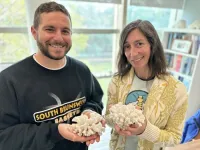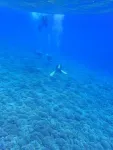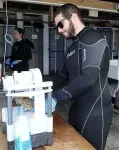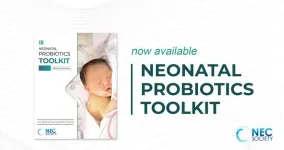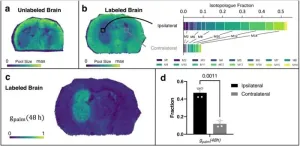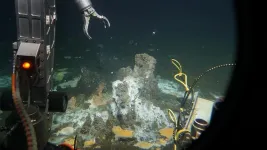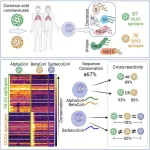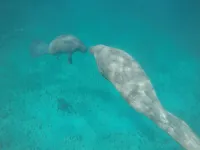The RNA fragments are from viruses that infected the symbionts as long ago as 160 million years. The discovery is described in an open-access study published this week in the Nature journal Communications Biology, and it could help scientists understand how corals and their partners fight off viral infections today. But it was a surprising find because most RNA viruses are not known for embedding themselves in the DNA of organisms they infect.
The research showed that endogenous viral elements, or EVEs, appear widely in the genomes of coral symbionts. Known as dinoflagellates, the single-celled algae live inside corals and provide them with their dramatic colors. The EVE discovery underscores recent observations that viruses other than retroviruses can integrate fragments of their genetic code into their hosts’ genomes.
“So why did it get in there?” asked study co-author Adrienne Correa of Rice University. “It could just be an accident, but people are starting to find that these ‘accidents’ are more frequent than scientists had previously believed, and they’ve been found across all kinds of hosts, from bats to ants to plants to algae.”
That an RNA virus appears at all in coral symbionts was also a surprise.
“This is what made this project so interesting to me,” said study lead author Alex Veglia, a graduate student in Correa’s research group. “There’s really no reason, based on what we know, for this virus to be in the symbionts’ genome.”
The study was supported by the Tara Ocean Foundation and the National Science Foundation and led by Correa, Veglia and two scientists from Oregon State University, postdoctoral scholar Kalia Bistolas and marine ecologist Rebecca Vega Thurber. The research provides clues that can help scientists better understand the ecological and economic impact of viruses on reef health.
The researchers did not find EVEs from RNA viruses in samples of filtered seawater or in the genomes of dinoflagellate-free stony corals, hydrocorals or jellyfish. But EVEs were pervasive in coral symbionts that were collected from dozens of coral reef sites, meaning the pathogenic viruses were — and probably remain — picky about their target hosts.
“There’s a huge diversity of viruses on the planet,” said Correa, an assistant professor of biosciences. “Some we know a lot about, but most viruses haven't been characterized. We might be able to detect them, but we don’t know who serves as their hosts.”
She said viruses, including retroviruses, have many ways to replicate by infecting hosts. “One reason our study is cool is because this RNA virus is not a retrovirus,” Correa said. “Given that, you wouldn’t expect it to integrate into host DNA.
“For quite a few years, we’ve seen a ton of viruses in coral colonies, but it’s been hard to tell for sure what they were infecting,” Correa said. “So this is likely the best, most concrete information we have for the actual host of a coral colony-associated virus. Now we can start asking why the symbiont keeps that DNA, or part of the genome. Why wasn’t it lost a long time ago?”
The discovery that the EVEs have been conserved for millions of years suggests they may somehow be beneficial to the coral symbionts and that there is some kind of mechanism that drives the genomic integration of the EVEs.
“There are a lot of avenues we can pursue next, like whether these elements are being used for antiviral mechanisms within dinoflagellates, and how they are likely to affect reef health, especially as oceans warm,” Veglia said.
“If we’re dealing with an increase in the temperature of seawater, is it more likely that Symbiodiniaceae species will contain this endogenous viral element? Does having EVEs in their genomes improve their odds of fighting off infections from contemporary RNA viruses?” he said.
“In another paper, we showed there was an increase in RNA viral infections when corals underwent thermal stress. So there are a lot of moving parts. And this is another good piece of that puzzle.”
Correa said, “We can’t assume that this virus has a negative effect. But at the same time, it does look like it’s becoming more productive under these temperature stress conditions.”
Thurber is the Emile F. Pernot Distinguished Professor in Oregon State’s Department of Microbiology.
The study included more than 20 co-authors from the University of Konstanz, Germany; the Institute of Microbiology and Swiss Institute of Bioinformatics, Zürich; the University of Perpignan, France; the Scientific Center of Monaco; the Université Paris-Saclay, Evry, France; the Tara Ocean Foundation, Paris; the University of Maine; Sorbonne University, France; the University of Tsukuba, Japan; Paris Science and Letters University, France; the University of Paris-Saclay; the Weizmann Institute of Science, Rehovot, Israel; Côte d’Azur University, Nice, France; the European Bioinformatics Institute, University of Cambridge, England; Ohio State University; and the National University of Ireland, Galway.
National Science Foundation support was provided by three grants (2145472, 2025457, 1907184).
-30-
Peer-reviewed paper:
“Endogenous viral elements reveal associations between a non-retroviral RNA virus and symbiotic dinoflagellate genomes” | Communications Biology | DOI: 10.1038/s42003-023-04917-9
Authors: Alex J. Veglia, Kalia S.I. Bistolas, Christian R, Voolstra, Benjamin C. C. Hume, Hans-Joachim Ruscheweyh, Serge Planes, Denis Allemand, Emilie Boissin, Patrick Wincker, Julie Poulain, Clémentine Moulin, Guillaume Bourdin, Guillaume Iwankow, Sarah Romac, Sylvain Agostini, Bernard Banaigs, Emmanuel Boss, Chris Bowler, Colomban de Varga, Eric Douville, Michel Flores, Didier Forcioli, Paola Furla, Pierre Galand, Eric Gilson, Fabien Lombard, Stéphane Pesant, Stéphanie Reynaud, Matthew B. Sullivan, Shinichi Sunagawa, Olivier Thomas, Romain Troublé, Didier Zoccola, Adrienne M.S. Correa, and Rebecca L. Vega Thurber
https://doi.org/10.1038/s42003-023-04917-9
VIDEO is available at:
https://youtu.be/0Kvlnaqg738
CAPTION: Symbiotic dinoflagellates, viewed from a dissecting microscope, are key to the health of reef-building corals. (Credit: Carsten Grupstra/Boston University)
Image downloads:
https://news-network.rice.edu/news/files/2022/12/1205_CORAL-1-WEB.jpg
CAPTION: Rice graduate student Alex Veglia and marine biologist Adrienne Correa co-led a study that found fragments of non-retroviruses in the genomes of coral symbionts. (Credit: Rice University)
https://news-network.rice.edu/news/files/2022/12/1205_CORAL-2-WEB.jpg
CAPTION: Marine biologists sample reefs of Pocillopora corals. Researchers at Rice University and Oregon State University studied corals and found fragments of non-retroviruses in the genomes of their symbionts, perhaps the result of infections millions of years ago. (Credit: Andrew Thurber/Oregon State University)
https://news-network.rice.edu/news/files/2022/12/1205_CORAL-3-WEB.jpg
CAPTION: Rice University graduate student Alex Veglia samples a coral for a study by researchers at Rice and Oregon State that found fragments of non-retroviruses in the genomes of coral symbionts. Rice marine biologist Adrienne Correa is in the background. (Credit: Courtesy of the Correa Lab/Rice University)
Related stories:
Ocean warming intensifies viral outbreaks within corals – April 3, 2023
https://news.rice.edu/news/2023/ocean-warming-intensifies-viral-outbreaks-within-corals
Adrienne Correa wins CAREER Award – March 28, 2022
https://news.rice.edu/news/2022/adrienne-correa-wins-career-award
Houston flooding polluted reefs more than 100 miles offshore – April 6, 2021
https://news.rice.edu/news/2021/houston-flooding-polluted-reefs-more-100-miles-offshore
Coral reefs fall victim to overfishing, pollution, ocean warming – June 7, 2016
https://news.rice.edu/2016/06/07/coral-reefs-fall-victim-to-overfishing-pollution-ocean-warming/
Marine virus outbreaks linked to coral bleaching – Feb. 17, 2016
http://news.rice.edu/2016/02/17/marine-virus-outbreaks-linked-to-coral-bleaching/
Related research:
Viruses of a key coral symbiont exhibit temperature-driven productivity across a reefscape:
https://www.researchsquare.com/article/rs-1899377/v1
Thermal stress triggers productive viral infection of a key coral reef symbiont:
https://www.nature.com/articles/s41396-022-01194-y
Links:
Correa Lab: http://www.owlnet.rice.edu/~ac53/index.html
Vega Thurber group: https://vegathurberlab.wixsite.com/microbiology
Tara Ocean Foundation: https://fondationtaraocean.org/en/foundation/
Department of BioSciences: https://biosciences.rice.edu
Wiess School of Natural Sciences: https://naturalsciences.rice.edu
Follow Rice News and Media Relations via Twitter @RiceUNews
This release is online at: https://news.rice.edu/news/2023/ancient-viruses-discovered-coral-symbionts-dna
Located on a 300-acre forested campus in Houston, Rice University is consistently ranked among the nation’s top 20 universities by U.S. News & World Report. Rice has highly respected schools of Architecture, Business, Continuing Studies, Engineering, Humanities, Music, Natural Sciences and Social Sciences and is home to the Baker Institute for Public Policy. With 4,240 undergraduates and 3,972 graduate students, Rice’s undergraduate student-to-faculty ratio is just under 6-to-1. Its residential college system builds close-knit communities and lifelong friendships, just one reason why Rice is ranked No. 1 for lots of race/class interaction and No. 4 for quality of life by the Princeton Review. Rice is also rated as a best value among private universities by Kiplinger’s Personal Finance.
END
